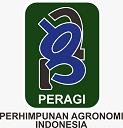Identification of Bacterial Soft Rot in Potatoes From Batu City, Indonesia
Abstract
Soft rot is a plant disease that can reduce both the quality and quantity of potato production, primarily caused by the Pectobacterium carotovorum. This study aims to isolate and identify the bacteria responsible for soft rot disease in potato tubers using molecular methods. Bacterial isolation was performed on a diseased potato tuber collected from Sumber Brantas Village, followed by a pathogenicity test, PCR, 16S rRNA gene sequencing, and phylogenetic analysis. Based on macroscopic and microscopic examination, four isolates exhibiting soft rot symptoms were identified: P1, P2, K5, and K7. The 16S rRNA sequencing results and BLAST analysis showed that isolate K5 was closely related to Serratia rubidaea, isolate P2 was closely associated with Pectobacterium carotovorum, isolate P1 was closely related to Pseudomonas koreensis, and isolate K7 was closely associated with Ralstonia pseudosolanacearum. This study presents the first molecular characterization of bacteria responsible for soft rot in potato tubers originating from Batu City, East Java. The findings provide foundational insights that may support the development of molecular-based diagnostic tools and region-specific disease management strategies for potato cultivation in Indonesia.
Keywords
Full Text:
PDFReferences
Badan Pusat Statistik. (2023). Produksi Tanaman Sayuran 2021-2023. https://www.bps.go.id/id/statistics-table/2/NjEjMg==/produksi-tanaman-sayuran.html
Charkowski, A., Blanco, C., Condemine, G., Expert, D., Franza, T., Hayes, C., Hugouvieux-Cotte-Pattat, N., Solanilla, E. L., Low, D., Moleleki, L., Pirhonen, M., Pitman, A., Perna, N., Reverchon, S., Palenzuela, P. R., Francisco, M. S., Toth, I., Tsuyumu, S., Van Der Waals, J., … Yedidia, I. (2012). The role of secretion systems and small molecules in soft-rot Enterobacteriaceae pathogenicity. Annual Review of Phytopathology, 50, 425–449. https://doi.org/10.1146/annurev-phyto-081211-173013
Charkowski, A. O. (2018). The Changing Face of Bacterial Soft-Rot Diseases. Annual Review of Phytopathology, 56, 269–288. https://doi.org/10.1146/annurev-phyto-080417-045906
Czajkowski, R., Pérombelon, M. C. M., Van Veen, J. A., & Van der Wolf, J. M. (2011). Control of Blackleg and Tuber Soft Rot of Potato Caused by Pectobacterium and Dickeya Species: A review. Plant Pathology, 60(6), 999–1013. https://doi.org/10.1111/j.1365-3059.2011.02470.x
Davidsson, P. R., Kariola, T., Niemi, O., & Tapio Palva, E. (2013). Pathogenicity of and Plant Immunity to Soft Rot Pectobacteria. Frontiers in Plant Science, 4(191), 2–13. https://doi.org/10.3389/fpls.2013.00191
Fang, Y., & Ramasamy, R. P. (2015). Current and prospective methods for plant disease detection. Biosensors, 5(3), 537-561. MDPI. https://doi.org/10.3390/bios5030537
Firmansyah, M. A., & Taufiqurrozif, B. H. (2024). Busuk akar pada pohon ketapang kencana (Terminalia mantaly). Jurnal Hutan Tropis, 12(3), 387–397.
Gupta, N. (2019). DNA Extraction and Polymerase Chain Reaction. Journal of Cytology, 36(2), 116–117. https://doi.org/10.4103/JOC.JOC_110_18
Hikmawati, F., Susilowati, A., & Setyaningsih, R. (2019). Colony Morphology and Molecular Identification of Vibrio Spp. on Green Mussels (Perna Viridis) in Yogyakarta, Indonesia tourism beach areas. Biodiversitas, 20(10), 2891–2899. https://doi.org/10.13057/biodiv/d201015
Joko, T., Kusumandari, N., & Hartono, S. (2011). Optimasi metode PCR untuk deteksi Pectobacterium carotovorum, penyebab penyakit busuk lunak anggrek. Jurnal Perlindungan Tanaman Indonesia, 17(2), 54–59.
Li, L., Yuan, L., Shi, Y., Xie, X., Chai, A., Wang, Q., & Li, B. (2019). Comparative Genomic Analysis of Pectobacterium carotovorum subsp. Brasiliense SX309 Provides Novel Insights Into Its Genetic and Phenotypic Features. BMC Genomics, 20(1), 1–17. https://doi.org/10.1186/s12864-019-5831-x
Maghfiroh, L., Munif, A., Nawangsih, A. A., & Akhdiya, A. (2022). Karakterisasi bakteri penyebab busuk lunak pada umbi porang (Amorphophallus muelleri) menggunakan Primer PCR Spesifik. Jurnal Ilmu Pertanian Indonesia, 27(3), 463–472. https://doi.org/10.18343/jipi.27.3.463.
Mariano, R., & Souza, E. B. (2011). Characterization and Variability of Soft Rot-Causing Bacteria in Chinese cabbage in North Eastern Brazil. Journal of Plant Pathology, 93(1), 173–181. https://www.researchgate.net/publication/236982194
Muturi, P., Yu, J., Maina, A. N., Kariuki, S., Mwaura, F. B., & Wei, H. (2019). Bacteriophages Isolated in China for the Control of Pectobacterium carotovorum Causing Potato Soft Rot in Kenya. Virologica Sinica, 34(3), 287–294. https://doi.org/10.1007/s12250-019-00091-7
Nawar, H. H., & Al-Juboory, H. H. (2023). Isolation and Diagnosis of the Bacterium Pectobacterium Caratovorium, the Causative Agent of Soft Rot Disease on Potatoes, Macroscopically and Biochemically. IOP Conference Series: Earth and Environmental Science, 1262(3), 10. https://doi.org/10.1088/1755-1315/1262/3/032062
Newell, P. D., Fricker, A. D., Roco, C. A., Chandrangsu, P., & Merkel, S. M. (2013). A Small-Group Activity Introducing the Use and Interpretation of BLAST. Journal of Microbiology & Biology Education, 14(2), 238–243. https://doi.org/10.1128/jmbe.v14i2.637
Noor, Y. R., & Hanani, N. (2025). Understanding Livelihood Assets of Potato Farmer Household in Probolinggo Regency , East Java Province , Indonesia. Agro Bali: Agricultural Journal, 8(1), 114–125.
Pritchard, L., Glover, R. H., Humphris, S., Elphinstone, J. G., & Toth, I. K. (2015). Genomics and Taxonomy in Diagnostics for Food Security: Soft-rotting enterobacterial plant pathogens. Analytical Methods, 8(1), 12–24. https://doi.org/10.1039/c5ay02550h
Ramlan, R. R., Harnelly, & Fitri, L. (2024). DNA Extraction and PCR Optimization of Coffea arabica L. and Coffea canephora Pierre ex A. Froehner. Jurnal Penelitian Pendidikan IPA, 10(SpecialIssue), 53–58. https://doi.org/10.29303/jppipa.v10ispecialissue.7881
Schaad, N. W., & Chun, W. (2001). Book Reviews : Book Reviews. In Laboratory Guide for Identification of Plant Pathogenic Bacteria, Third Edition. (Vol. 28, Issue 3, pp. 951–951). https://doi.org/10.1177/001316446802800332
Stackebrandt, E., & Goebel, B. M. (1994). Taxonomic note: a place for DNA-DNA Reassociation and 16s rRNA Sequence Analysis in The Present Species Definition in Bacteriology. International Journal of Systematic Bacteriology, 44(4), 846-849. https://doi.org/10.1016/S0140-6736(01)43317-4
Stover, N. A., & Cavalcanti, A. R. O. (2017). Using NCBI BLAST. Current Protocols in Essential Laboratory Techniques, 1(1), 1–34. https://doi.org/10.1002/cpet.8
Su, W., & Wang, J. (2019). Potato and Food Security in China. American Journal of Potato Research, 96(2), 100–101. https://doi.org/10.1007/s12230-018-09709-0
Suárez, M. B., Diego, M., Feria, F. J., Martín-Robles, M. J., Moreno, S., & Palomo, J. L. (2022). New PCR-Based Assay for The Identification of Pectobacterium carotovorum causing Potato Soft Rot. Plant Disease, 106(2), 676–684. https://doi.org/10.1094/PDIS-08-21-1676-RE
Syah, M. A., Yaddi, Y., & Ulfa, N. I. (2024). Identifikasi Molekuler Bakteri Lipolitik yang Diisolasi dari Sedimen Mangrove Teluk Kendari. Jurnal Penelitian Biologi (Journal of Biological Research), 11(1), 68–77.
Tamura, K., Stecher, G., & Kumar, S. (2021). MEGA11: Molecular Evolutionary Genetics Analysis Version 11. Molecular Biology and Evolution, 38(7), 3022–3027. https://doi.org/10.1093/molbev/msab120
Van Gijsegem, F., Toth, I. K., & van der Wolf, J. M. (2021). Plant diseases caused by Dickeya and Pectobacterium species. In Plant Diseases Caused by Dickeya and Pectobacterium Species. Springer International Publishing. https://doi.org/10.1007/978-3-030-61459-1
Zymo Research. (2021). Quick-DNA TM fungal / bacterial miniprep kit. https://files.zymoresearch.com/protocols/_d6005_quick-dna_fungal-bacterial_miniprep_kit.pdf
Refbacks
- There are currently no refbacks.



























